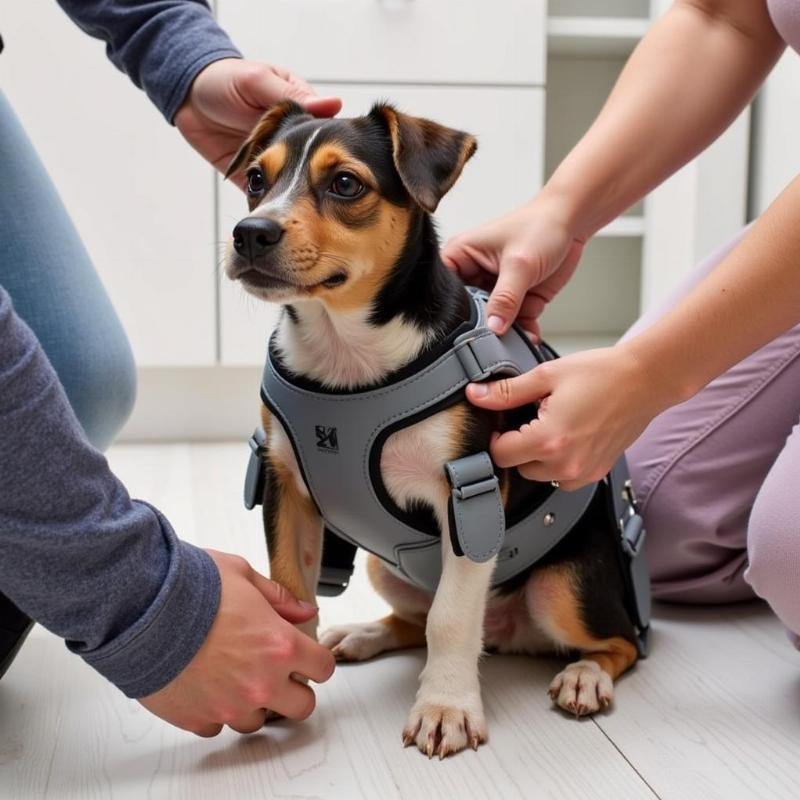Dog braces for back legs are becoming increasingly popular among pet owners in the US, offering a way to support injured or weak limbs, improve mobility, and enhance a dog’s overall quality of life. Whether your furry friend is suffering from arthritis, recovering from surgery, or experiencing age-related weakness, a back leg brace can be a crucial tool in their recovery and ongoing comfort. Understanding the different types of braces, their proper usage, and the potential benefits can empower you to make the best decision for your beloved companion.
Choosing the Right Dog Brace for Back Leg Issues
Selecting the appropriate dog brace for back leg problems requires careful consideration of your dog’s specific needs and condition. Several factors influence this decision, including the nature of the injury or weakness, the size and breed of your dog, and the intended use of the brace. For example, a brace designed for post-operative recovery will differ significantly from one meant to provide long-term support for arthritis. Consulting with your veterinarian is highly recommended, as they can accurately diagnose the underlying issue and recommend the most suitable brace.
Different types of braces are designed to address specific needs. A hock brace, for instance, focuses support on the ankle joint, while a knee brace stabilizes the stifle joint. Full leg braces provide more comprehensive support, encompassing the entire leg from hip to paw. Furthermore, braces vary in terms of materials and construction. Some are made from neoprene for flexibility and compression, while others incorporate rigid supports for greater stability.
Benefits of Using Dog Braces for Back Legs
Dog braces offer a multitude of benefits for dogs struggling with back leg weakness or injury. They provide stability and support, reducing pain and discomfort during activity. This enhanced stability can also help prevent further injury, particularly in dogs prone to slips, falls, or joint instability. Improved mobility is another significant advantage, allowing dogs to engage in activities they might otherwise find difficult or painful. treatment for dogs with weak hind legs can involve a combination of therapies, including bracing, medications, and physical therapy.
For older dogs, back leg braces can be invaluable in maintaining their quality of life. Age-related conditions like arthritis can significantly impact mobility, making everyday tasks challenging. A brace can provide the necessary support to alleviate pain and allow senior dogs to continue enjoying walks and playtime. back leg support for old dogs is an essential aspect of senior dog care.
Proper Usage and Care of Dog Braces
While dog braces offer numerous benefits, proper usage and care are crucial for maximizing their effectiveness and preventing complications. Always follow the manufacturer’s instructions carefully when fitting and adjusting the brace. A properly fitted brace should be snug but not constricting, allowing for comfortable movement. Regularly inspect the brace for signs of wear and tear, and clean it according to the manufacturer’s recommendations. brace for dogs back legs comes with specific care instructions that should be followed diligently.
 Proper Usage and Care of Dog Braces
Proper Usage and Care of Dog Braces
Introducing the brace gradually is essential, allowing your dog to acclimate to its presence. Start with short wearing periods and gradually increase the duration as your dog becomes more comfortable. Monitor your dog closely for any signs of discomfort or skin irritation, and consult your veterinarian if any issues arise. dog leg injuries back leg require careful monitoring, even with a brace.
Conclusion: Supporting Your Dog’s Mobility and Well-being with Back Leg Braces
Dog braces for back legs can be a valuable tool in managing a variety of conditions, from injuries to age-related weakness. By providing support, stability, and pain relief, these braces can greatly improve a dog’s mobility and overall quality of life. Choosing the right brace, using it correctly, and providing proper care are crucial for achieving optimal results. Remember to consult with your veterinarian to determine the best course of action for your dog’s specific needs. With the right support, your furry friend can continue to enjoy an active and fulfilling life.
FAQ
- How long can my dog wear a back leg brace? This depends on your dog’s individual needs and the type of brace. Consult your veterinarian for specific recommendations.
- Can my dog sleep with a back leg brace on? Generally, it’s best to remove the brace at night to allow the skin to breathe and prevent pressure sores.
- Are dog braces expensive? The cost varies depending on the type and brand of brace.
- How do I clean my dog’s back leg brace? Follow the manufacturer’s instructions for cleaning. Most braces can be hand-washed with mild soap and water.
- Can a brace cure my dog’s leg problem? Braces provide support and manage symptoms, but they typically don’t cure underlying conditions.
- What if my dog doesn’t like the brace? Introduce the brace gradually and reward your dog for wearing it. If your dog continues to resist, consult your veterinarian.
- Are there different sizes of dog braces available? Yes, braces come in various sizes to fit different breeds and sizes of dogs.
Related Articles
Beautdogs.us is your premier online destination for all things dog-related in the US. We provide expert advice, breed information, and a curated selection of products to enhance your dog’s life. Whether you’re a new dog owner or a seasoned expert, Beautdogs.us offers a wealth of reliable information to help you care for your canine companion. Contact us for more information at [email protected] or +1 501-555-7529.